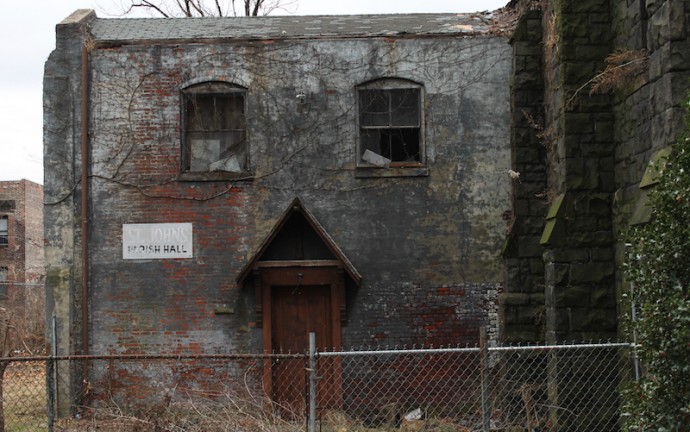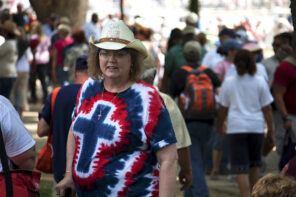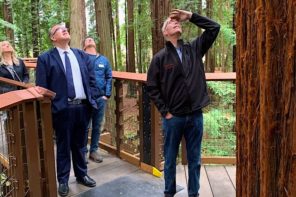In recent posts about religious “nones,” or individuals without a religious affiliation, Mark Silk and Chris Stedman at the Religion News Service address the potential relationship between the emergence of the “New Atheists” and the rise of the “nones.” According to Silk, it’s unlikely that the New Atheists are responsible for the growing statistical prominence of “nones” as Sam Harris and Richard Dawkins hit the bestseller lists a good 10-15 years after the uptick in “nones” back in the 1990s. It’s important to recall, however, that the presence of Americans who find Saturday- or Sunday-morning solace in nature or the newspaper goes back quite a bit further, though the questions have remained eerily consistent from one era to another.
Today’s religious “nones” encompass both atheists and those who believe in God (68% of nones are believers, according to Pew). Indeed, both secular and religious unaffiliated people draw on a much longer history that reaches back into the late nineteenth century. Several scholars of American religious history, including Leigh Eric Schmidt and Catherine Albanese (whose relevant works were cited in RD’s “Five Must-Reads on the Nones”) have teased out strands of this older pattern of life on the margins of religious affiliation. A century ago, the religious “nones” were coming, and just as today, religious leaders wondered what they could do to stop the flow away from church or synagogue.
Recognizing that many were leaving religion because its doctrines no longer matched their modern views or sympathies, some like-minded leaders sought to create new traditions. One such movement was the Society for Ethical Culture, founded in 1876 by Felix Adler, a Reform Jew who created a post-Jewish religion of “deed rather than creed.”
The Sunday morning meetings of the original New York Society for Ethical Culture included music and a spoken address. Membership drew from the upper echelons of New York society, including many prominent Jewish leaders. Adler’s reason for holding such ritualistically bare services are surprisingly relevant, perhaps, to today’s religious “nones.” Said Adler: “You may have holier moods on a Tuesday than on a Sunday; you may enter into larger communion with the spirit of nature in the woods or by the sea. You may! But, as a matter of fact, actually do you?” Wouldn’t it be better to attend any kind of service—even one as secular as theirs—to increase the chances of having that kind of uplift? Adler’s implied question raises a point still relevant to unaffiliated Americans of today: does a life without religious institutions offer the same benefits as one lived in the context of a religious tradition?
Another Ethical Culture leader, Percival Chubb of the Ethical Society of St. Louis, offered even more potent commentary in 1931 which relates to the similarities between what he referred to as the “strays on the religious frontier” and today’s “nones.” He called the world of the “nones” the “territory of the unchurched,” where people “have left the churches to which they belonged—mainly by accident of birth—to join the ranks of the unattached. Some hesitate: there are children with them.”
Like Adler, he hoped that Ethical Culture would provide a “refuge” for those considering leaving traditional religious observance. Perhaps, rather than disaffiliate or become secularized atheists, they might find a home in Ethical Culture. The types of people Chubb saw leaving the churches sound eerily similar to today’s unaffiliated believers and nonbelievers. They consisted of:
1) Educated, urban members of the middle- and upper-class: “the ‘intellectuals,’ who will frankly tell you that they have ceased to feel any religious needs. They are readers; they are actively interested in the cultural movements of their time—the arts, music, drama, philosophy, politics—and these suffice them, they believe, for the inner life.”
2) Special-occasion attendees: “They are once-or-twice-a-year worshippers—at Easter or Christmas—and cling to a family tradition.”
3) Nature lovers: “Others like ‘a book of verses underneath the bough,’ or may cherish what Wordsworth called ‘natural piety.’”
For Chubb, and for others like him, the question of the day was similar to ones being asked today: Can this flight from the churches be stopped? Chubb feared that these wayfarers on the frontier would “become individualists and isolationists so far as religion is concerned, each ‘going it alone.’”
Chubb’s words, so similar to Robert Putnam’s “bowling alone,” resonate clearly today, and they offer a warning to those who bemoan what such high numbers of “nones” means for the future of America’s churches. Chubb believed that Ethical Culture, and other like-minded groups such as the Unitarians, offered a creedless religion inoffensive to modern thought, which would therefore appeal to the progressive-minded, rational, upscale, worldly individuals statistically more likely to comprise the “nones.”
History, however, has not borne out this belief. Liberal mainline churches bleed members annually, and alternatives to traditional denominations such as Ethical Culture or Unitarian Universalism, which offer even more comfort with the mores of the age, remain a tiny statistical minority. Religious nones, whether atheist or unaffiliated believer, are simply that, people without religious affiliation. No matter how liberal or secular a congregation’s doctrine might be, they live quite well, thank-you-very-much, without it.
The longer history of religious liberalism’s failure to stem the tide of strays into the religious frontier will remain a vexing problem for today’s religious leaders, even as it was over a century ago. Ironically, it was during that same era—the late 19th century—that secularism and positivism, the New Atheists’s forebears, first enjoyed a “golden age” in American culture, as historians such as Jackson Lears have noted. The religious “nones” are coming, and while there may be little anyone can do to stop this trend, it doesn’t appear as though aggressive atheism has ever done much to accelerate it either.





